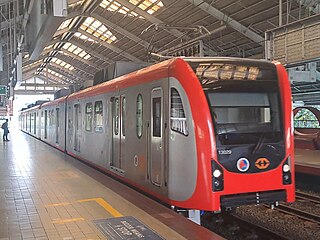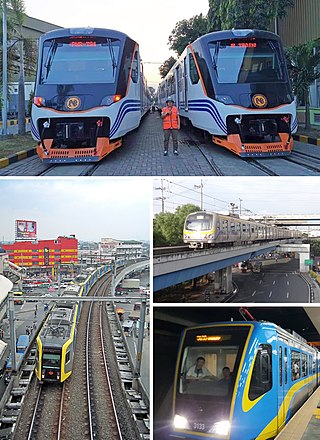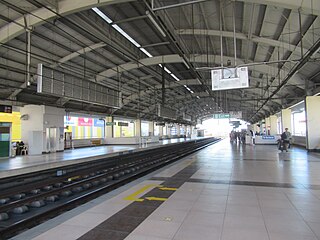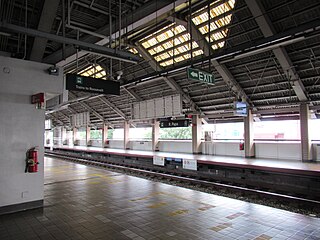
The Manila Light Rail Transit System, commonly known as the LRT, is an urban rail transit system that primarily serves Metro Manila, Philippines. Although categorized as a light rail system because it originally used light rail vehicles, it presently has characteristics of a rapid transit system, such as high passenger throughput, exclusive right-of-way, and later use of full metro rolling stock. The LRT is jointly-operated by the Light Rail Transit Authority (LRTA), a government corporation attached to the Department of Transportation (DOTr), and the Light Rail Manila Corporation (LRMC). Along with the Manila Metro Rail Transit System and the Metro Commuter Line of the Philippine National Railways, the system makes up Metro Manila's rail infrastructure.

The Metro Rail Transit Line 3, also known as the MRT Line 3, MRT-3, or Metrostar Express, is a rapid transit line in Metro Manila in the Philippines. The line runs in an orbital north to south route following the alignment of Epifanio de los Santos Avenue (EDSA). Despite its name, the line is more akin to a light rapid transit system owing to its tram-like rolling stock while having total grade separation and high passenger throughput. The line is officially known as the Yellow Line. Its current General Manager is Oscar Bongon.

Rail transportation in the Philippines is currently used mostly to transport passengers within Metro Manila and provinces of Laguna and Quezon, as well as a commuter service in the Bicol Region. Freight transport services once operated in the country, but these services were halted. However, there are plans to restore old freight services and build new lines. From a peak of 1,100 kilometers (680 mi), the country currently has a railway footprint of 533.14 kilometers (331.28 mi), of which only 129.85 kilometers (80.69 mi) are operational as of 2024, including all the urban rail lines. World War II, natural calamities, underspending, and neglect have all contributed to the decline of the Philippine railway network. In the 2019 Global Competitiveness Report, the Philippines has the lowest efficiency score among other Asian countries in terms of efficiency of train services, receiving a score of 2.4, and ranking 86th out of 101 countries globally. The government is currently expanding the railway network up to 1,900 kilometers (1,200 mi) by 2022 through numerous projects.

Monumento station is an elevated Light Rail Transit (LRT) station located on the LRT Line 1 (LRT-1) system in the southern portion of Caloocan. It is named after the most famous landmark of Caloocan, the Monumento Circle, which houses the Bonifacio Monument, a famous monument to Filipino revolutionary Andrés Bonifacio. The name Monumento itself is derived from the Spanish word for monument. It opened on May 12, 1985, when LRT-1 became fully operational. Being the northern terminus of LRT-1 until Balintawak was opened in 2010, it is called Monumento Terminal and historically as North Terminal.

EDSA station is an elevated Light Rail Transit (LRT) station located on the LRT Line 1 (LRT-1) system in Pasay. The station is situated on the intersection of Taft Avenue and Epifanio de los Santos Avenue, better known as EDSA, one of Metro Manila's major thoroughfares. The station and the avenue are both named after Epifanio de los Santos, a noted historian.

The Light Rail Transit Authority (LRTA) is a public transport operator that is responsible for the construction, operation, maintenance and/or lease of Manila Light Rail Transit System in the Philippines. It is organized as a government-owned and controlled corporation under the Department of Transportation (DOTr) as an attached agency.

Libertad station is an elevated Light Rail Transit (LRT) station located on the LRT Line 1 (LRT-1) system in Pasay, Metro Manila, Philippines. It is situated at the intersection of Taft Avenue and Arnaiz Avenue. The station is named after the former Libertad Street, now a part of Arnaiz Avenue. The name Libertad survives as an area name after the old street.

The Light Rail Transit Line 1, commonly referred to as LRT Line 1 or LRT-1, is a light rapid transit system line in Metro Manila, Philippines, operated by Light Rail Manila Corporation (LRMC) and owned by the Light Rail Transit Authority (LRTA) as part of the Manila Light Rail Transit System. Originally referred to as Metrorail and the Yellow Line, LRT Line 1 was reclassified to be the Green Line in 2012. It travels in a general north–south direction from Dr. Santos to Monumento, and then east–west from Monumento to Fernando Poe Jr. Currently, the line consists of 25 stations and runs on 26 kilometers of fully elevated route. Although it has the characteristics of light rail, such as with the type of rolling stock used, it is more akin to a rapid transit system owing to its total grade separation and high passenger throughput.

The Light Rail Transit Line 2, also known as LRT Line 2, LRT-2, or Megatren, is a rapid transit line in Metro Manila in the Philippines owned and operated by the Light Rail Transit Authority (LRTA). The line generally runs in an east–west direction between Recto in Manila and Antipolo. The line is officially referred to as the Purple Line.

Taft Avenue station is the southern terminus of the Metro Rail Transit Line 3 (MRT-3) system located in Pasay. It is situated at the intersection of Epifanio de los Santos Avenue (EDSA), one of Metro Manila's major thoroughfares, and Taft Avenue, usually referred to as Pasay Rotonda or EDSA-Taft. The station is named after Taft Avenue.

The Metro Rail Transit Corporation (MRTC), is a private consortium organized in June 1995. The consortium is composed of seven (7) Filipino-owned companies: Fil-Estate Management Inc, Ayala Land Inc, Ramcar Inc, Greenfield Development Corporation of Unilab, Anglo-Philippine Holdings Corporation, National Book Store Group, Allante Realty and Development Inc, and DBH Inc. The Metro Rail Transit Corporation owns the Manila Metro Rail Transit System Line 3 running along the EDSA corridor. MRTC was the original contractor for the EDSA MRT-3 Project. It runs the MRT-3 in coordination with the Department of Transportation under a 25-year Build-Lease-Transfer contract or BLT Agreement, which will end in 2025.

Fernando Poe Jr. station is the current northern terminus of the Light Rail Transit Line 1 (LRT-1) system. It opened on October 22, 2010, as part of the LRT-1 North Extension Project, as Roosevelt and got its current name on August 20, 2023, almost two years after the namesake avenue was officially renamed after the Filipino actor.

The North Triangle Common Station, commonly known as the Common Station or North Triangle station, is an under-construction rapid transit terminal and transport hub that will connect LRT Line 1, MRT Line 3, and MRT Line 7, and the nearby Metro Manila Subway. It is located in Bagong Pag-asa, Quezon City, Philippines, and is named after its location, which is at the corner of EDSA and North Avenue.

R. Papa station is an elevated Light Rail Transit (LRT) station located on the LRT Line 1 (LRT-1) system in Tondo, Manila, Philippines. It is situated on Rizal Avenue Extension in Barrio Obrero. The station is named after Ricardo Papa Street, which is in turn named after a former Manila police chief-turned-Commanding General of the Philippine Army. The station is the first station in Rizal Avenue Extension going north and the last in the city of Manila, located just next to the city's boundary with Caloocan.

Rizal Avenue, also known as Avenida Rizal or simply Avenida, is one of Manila's main thoroughfares, running with two to six lanes from its Santa Cruz and Quiapo districts to the Bonifacio Monument (Monumento) Circle in Caloocan. Named after the national hero José Rizal, it is a part of Radial Road 9 (R-9). The LRT Line 1 elevated railway is built above the street throughout its entire length, and several jeepneys ply the area, taking passengers from Caloocan, Quezon City, and Valenzuela. Most of the street is within Santa Cruz, Manila. The avenue forms part of National Route 150 (N150) of the Philippine highway network.

The transportation system in Metro Manila covers the road network, rail network, ferries, ports and airports located within the metropolitan Manila area. Road transportation in Metro Manila is diverse, composed of many types of private and public transport vehicles. These include taxis, buses, jeepneys, tricycles and pedicabs. In some areas, especially in Divisoria and large public markets, two-stroke motors are fitted in the pedicabs and are used for goods transport. Regardless of modernity, horse-drawn kalesas are still used in the streets of Binondo and Intramuros. Ridesharing services such as Grab also operate within Metro Manila.
The Light Rail Transit Line 6 is a proposed rapid transit system in Cavite, Philippines. There have been two proposals for the line, with the first one shelved immediately in 2018. Another proposal emerged in 2017 and is currently under review by the National Economic and Development Authority (NEDA).

The LRTA 1000 class is the first-generation class of high-floor light rail vehicles (LRV) of the LRT Line 1.

Rail transportation in the Greater Manila Area is a major part of the transportation system in Metro Manila and its surrounding areas. The railway network, collectively known as the Greater Capital Region Railway System, consists of the Manila Light Rail Transit System (LRT), Manila Metro Rail Transit System (MRT), and Philippine National Railways lines within the region.
















